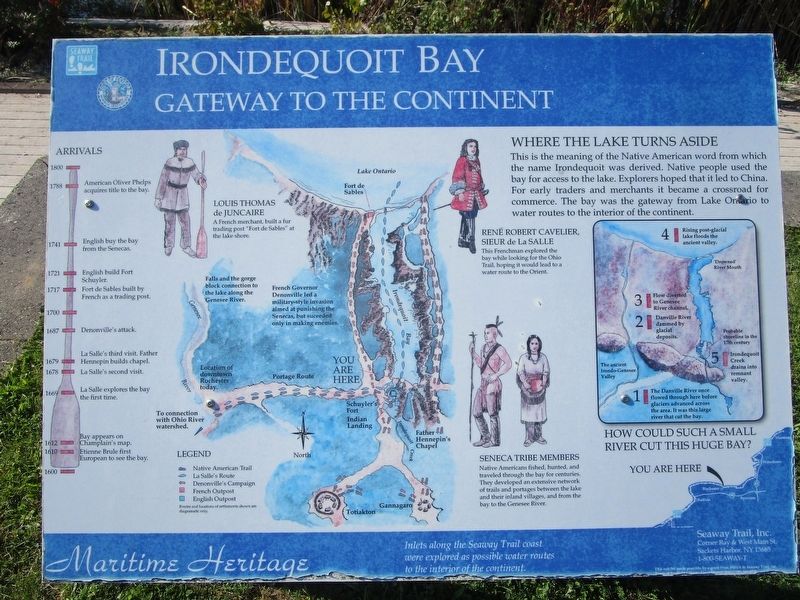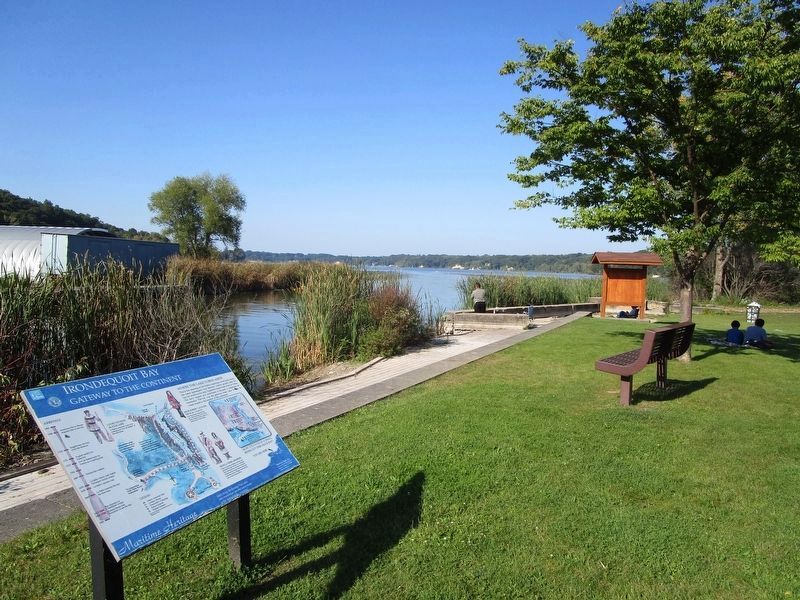Webster in Monroe County, New York — The American Northeast (Mid-Atlantic)
Irondequoit Bay
Gateway to the Continent
— Maritime History —
Where the Lake Turns Aside.
This is the meaning of the Native American word from which the name Irondequoit was derived. Native people used the bay for access to the lake. Explorers hoped that it led to China. For early traders and merchants it became a crossroad for commerce. The bay was the gateway from Lake Ontario to water routes to the interior of the continent.
René Robert Cavelier Sieur de La Salle. This Frenchman explored the bay while looking for the Ohio Trail, hoping it would lead to a water route to the Orient.
Louis Thomas de Juncaire. A French merchant, built a fur trading post "Fort de Sables" at the lake shore.
French Governor Denonville led a military-style invasion aimed at punishing the Senecas, but succeeded only in making enemies.
Falls and the gorge block connection to the lake along the Genesee River.
Seneca Tribe Members. Native Americans fished, hunted, and traveled through the bay for centuries. They developed an extensive network of trails and portages between the lake and their inland villages, and from the bay to the Genesee River.
How Could Such a Small River Cut This Huge Bay?
1| The Danville River once flowed through here before glaciers advanced across the area. It was this large river that cut the bay.
2| Danville River dammed by glacial deposits.
3| Flow diverted to Genesee River channel.
4| Rising post-glacial lake floods the ancient valley.
5| Irondequoit Creek drains into remnant valley.
Arrivals
1788- American Oliver Phelps acquires title to the bay.
1741- English buy the bay from the Senecas.
1721- English build Fort Schuyler.
1717- Fort de Sables built by French as a trading post.
1687- Denonville's attack.
1679- Las Salle's third visit. Father Hennepin builds chapel.
1678- La Salle's second visit.
1669- La Salle explores the bay the first time.
1612- Bay appears on Champlain's map.
1610- Etienne Brule first European to see the bay.
Inlets along the Seaway Trail coast were explored as possible water routes to the interior of the continent.
Erected by Seaway Trail, Inc.
Topics and series. This historical marker is listed in these topic lists: Exploration • Native Americans • Waterways & Vessels. In addition, it is included in the Great Lakes Seaway Trail National Scenic Byway series list.
Location. 43° 10.582′ N, 77° 31.568′ W. Marker is in Webster, New York, in Monroe County. Marker can be reached from Empire Boulevard (New York State Route 404
) ¾ mile east of Winton Road, on the left when traveling east. Marker is in LaSalles Landing Park at the southern end of Irondequoit Bay and the inflow of Irondequoit Creek. Touch for map. Marker is at or near this postal address: 1080 Empire Boulevard, Webster NY 14580, United States of America. Touch for directions.
Other nearby markers. At least 8 other markers are within 3 miles of this marker, measured as the crow flies. A different marker also named Irondequoit Bay (approx. ¼ mile away); Asa Dunbar (approx. one mile away); An Early Doctor (approx. 1.3 miles away); Indian Landing (approx. 1.8 miles away); Camp Site 1687 (approx. 2½ miles away); Swayne's Corners (approx. 2.6 miles away); Brighton Village (approx. 2.6 miles away); Harper Method (approx. 2.9 miles away).
Credits. This page was last revised on September 24, 2017. It was originally submitted on September 23, 2017, by Anton Schwarzmueller of Wilson, New York. This page has been viewed 852 times since then and 89 times this year. Photos: 1, 2. submitted on September 23, 2017, by Anton Schwarzmueller of Wilson, New York.

